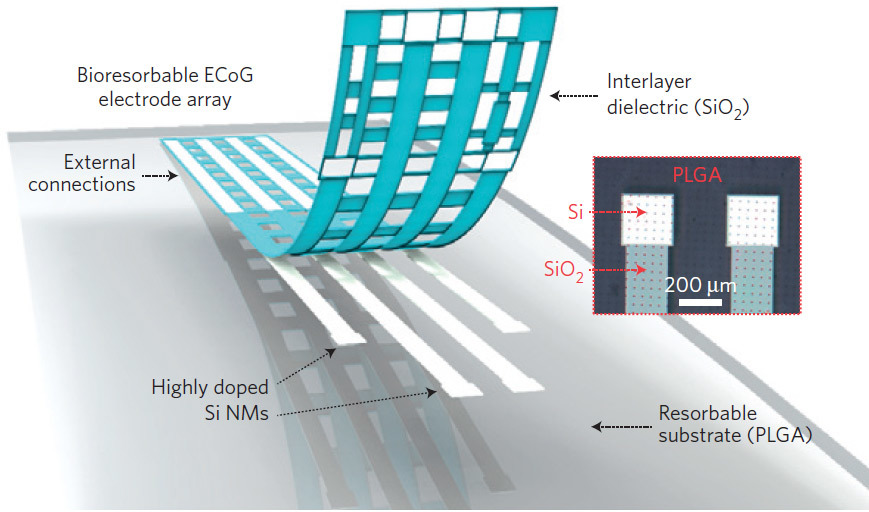Implantable electronics self-absorbing in the brain

The design of the array of self-absorbable neuroelectrodes for subcutaneous ECG and EEG measurements. The photolithography method is N-doped silicon 300 nm thick as electrodes and interconnects. A SiO 2 film 100 nm thick and a PLGA foil 30 nm thick are biodegradable encapsulating layer and substrate, respectively. The device is connected to an external system for transmitting data through a conductive film interconnected with Si NM interconnects on a contact pad.

Two scientific groups In the USA and China, independently of each other, almost simultaneously presented electronic devices from biodegradable components that can be safely implanted into a human brain, never removing back.
Researchers from the University of Pennsylvania have developed electrodes and electrode arrays of silicon and molybdenum layers, which are capable of detecting brain neuropulses and dissolve at a given speed, depending on the thickness of the material.
Implants have already been tested on anesthetized rats, removing their electrocardiogram and registering induced epileptic spike waves.

The installation of the electrodes inside the skull is carried out using a relatively simple operation.

The experiment showed that in the experimental rat the ECG is accurately recorded 32 days after the operation.
In an article for Nature Materials magazine (doi: 10.1038 / nmat4624, pdf) the authors of the paper emphasize that the device implanted into the skull of the device measures brain activity no worse than ordinary metal electrodes. In addition, such devices can help in accurate mapping of the brain before complex neurosurgical procedures, in the postoperative monitoring, as well as the basis for the creation of more complex brain implants.
The research was carried out thanks to grants from several organizations, including the US military research agency DARPA.
Around the same direction, the Chinese colleagues are exploring. They published a paper (doi: 10.1021 / acsami.5b10414, pdf) with a description of a memristor of biodegradable components using a 30-nm film of egg white deposited on a silicon film substrate with magnesium and tungsten electrodes.

The memristor showed high performance, which is not inferior to memristors based on metal oxides. The device stores information for more than 10,000 seconds in unchanged form, demonstrates high stability and reliability.
In the wet conditions of the laboratory, the memristor worked reliably for more than three months, and the albumin separated from the silicon film after 10 hours. The remains of the chip dissolved within three days.
